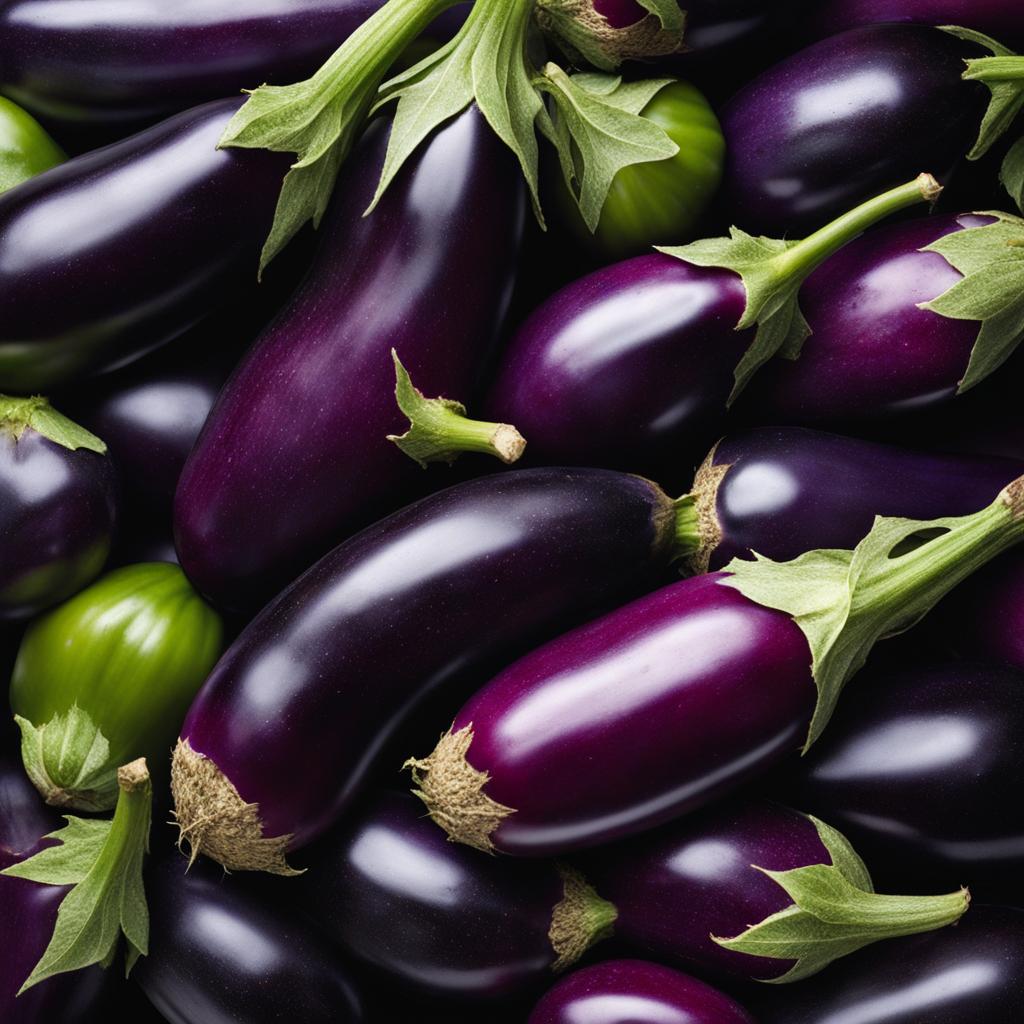As a food lover, I know how disappointing it is to find a spoiled ingredient in your pantry. That’s why I’m here to help you avoid any culinary disasters when it comes to eggplant. In this visual guide, we will explore the key indicators that will help you determine if your eggplant has gone bad or is still fresh and ready to be cooked.
Eggplant can be a tricky vegetable to assess, but with a little knowledge, you can easily spot the signs of spoilage. By checking the color, texture, and smell, you can quickly determine if your eggplant is still good to use. No more second-guessing about whether or not it’s safe to cook that eggplant sitting in your fridge!
Key Takeaways:
- Checking the color, both inside and outside, is crucial in determining if an eggplant is bad.
- Inspect the stem and cap for any signs of mold or discoloration.
- The skin should be glossy, taut, and free of cracks or shriveling.
- The flesh should be firm but give slightly when pressed, without any sliminess or dark spots.
- A fresh and earthy odor indicates a good eggplant, while a foul smell suggests spoilage.
How to Cook Eggplant
Before diving into the various cooking methods for eggplant, it’s crucial to ensure that the eggplant is fresh and not spoiled. Refer to the indicators mentioned in the previous section to determine the freshness of the eggplant. Once you’ve confirmed its quality, you can explore different cooking techniques to bring out the flavors and textures of this versatile vegetable.
Eggplant can be cooked using methods such as frying, grilling, or baking, depending on your preference and the recipe you’re following. Each method offers a unique taste profile and texture to elevate your dishes. For example, frying eggplant can result in a crispy exterior and a creamy interior, perfect for dishes like eggplant Parmesan. Grilling eggplant enhances its smoky flavor, adding depth to salads or sandwiches. Baking eggplant is a healthier option that still yields a tender and flavorful result, ideal for dishes like eggplant lasagna.
When preparing eggplant for cooking, start by washing it thoroughly and removing the stem. Depending on the recipe, you may need to slice the eggplant into rounds, cubes, or strips. It’s important to follow recipe instructions carefully to ensure the desired outcome. If you find that the eggplant has a slightly bitter taste, you can salt it and let it sit for a short period. This process helps remove some of the bitterness, resulting in a more balanced flavor.
| Cooking Method | Description |
|---|---|
| Frying | Fry the eggplant slices until they become golden brown and crispy on the outside. |
| Grilling | Brush the eggplant slices with oil and grill them until they develop grill marks and a smoky flavor. |
| Baking | Place the eggplant in the oven and bake until it becomes tender and slightly golden. |
Experiment with different cooking methods and recipes to discover your favorite way to cook eggplant. Whether you’re a fan of hearty, comforting dishes or prefer light and fresh flavors, eggplant offers endless possibilities to satisfy your culinary cravings.
Remember, the key to cooking eggplant successfully lies in selecting fresh and high-quality eggplants, prepping them correctly, and following recipe instructions. With these tips in mind, you can confidently incorporate eggplant into your cooking repertoire and enjoy the wonderful flavors and textures it brings to your meals.
Preservation and Storage
Eggplant, like many other fresh produce, requires proper storage to maintain its freshness and extend its shelf life. By following a few simple guidelines, you can ensure that your eggplant stays in good condition for as long as possible.
Storage Tips
When it comes to storing eggplant, it is important to keep it in a cool, dry place away from direct sunlight and humidity. This helps prevent premature spoiling and mold growth. A pantry or a basement storage area with good ventilation is ideal for keeping your eggplant fresh.
If you prefer to refrigerate your eggplant, make sure to store it in the crisper drawer to protect it from exposure to ethylene gas. Ethylene gas is produced by certain fruits and vegetables and can speed up the ripening process of eggplants, causing them to spoil more quickly.
Freezing for Long-Term Preservation
If you find yourself with an abundance of eggplant and want to preserve it for future use, freezing is an excellent option. Freezing eggplant allows you to enjoy its flavors and nutrients even when it’s out of season.
To freeze eggplant, start by washing it thoroughly and removing any stems or leaves. Cut the eggplant into slices or cubes, blanch them in boiling water for a few minutes, then drain and cool them. Once cooled, transfer the eggplant pieces into freezer bags or airtight containers and store them in the freezer.
Remember to label the bags or containers with the date to keep track of how long the eggplant has been frozen. Frozen eggplant can last for up to six months if stored properly.
Table: Proper Eggplant Storage
| Storage Method | Duration |
|---|---|
| Room temperature | 3 to 5 days |
| Refrigerator (crisper drawer) | Up to 1 week |
| Freezer (properly frozen) | Up to 6 months |
When thawing frozen eggplant, it is best to do so in the refrigerator to maintain its texture and quality. Simply transfer the frozen eggplant from the freezer to the fridge and allow it to thaw overnight.
By following these storage and preservation guidelines, you can ensure that your eggplant remains fresh and delicious, ready to be enjoyed in a variety of recipes.
Choosing the Freshest Eggplant for Your Recipes
When it comes to selecting eggplants for your culinary creations, freshness is key. To ensure you’re picking the best eggplant, there are a few visual cues to look out for. Here’s a guide to selecting fresh eggplant:
- Color: Opt for eggplants with a vibrant and deep purple hue. Avoid those with brown or yellowed skin, as they may be overripe.
- Skin Texture: Check for smooth and shiny skin. Avoid eggplants with blemishes, bruises, or a dull appearance.
- Stem: The stem of a fresh eggplant should be green and fresh-looking. Steer clear of eggplants with dry or shriveled stems.
- Weight: A fresh eggplant should feel heavy for its size. Avoid eggplants that feel light, as they may have begun to dry out.
- Smell: Trust your nose! A fresh eggplant should emit a mild earthy aroma. If it has a strong or unpleasant smell, it may be starting to spoil.
Remember, selecting the right eggplant is essential for achieving the best flavor and texture in your dishes.
By paying attention to these visual cues, you can confidently choose the freshest eggplants for your recipes. Whether you’re grilling, roasting, or frying, starting with a high-quality eggplant is a great first step toward a delicious meal.
Tips for Ripening Eggplant at Home
If you happen to buy an eggplant that’s slightly underripe, don’t worry! You can ripen it at home by placing it in a paper bag at room temperature. The eggplant will continue to ripen over the next few days. Keep an eye on it to ensure it doesn’t become overripe.
How to Use Eggplant
Eggplant is a versatile vegetable that can be used in a variety of recipes, adding unique flavors and textures to dishes. From appetizers to main courses, here are some delicious ways to incorporate eggplant into your meals:
1. Grilled Eggplant
Grilling eggplant brings out its natural smoky flavor and adds a delicious charred taste. Simply brush the eggplant slices with olive oil, sprinkle with salt and pepper, and grill them until they are tender and slightly browned. Grilled eggplant can be enjoyed as a side dish or used in sandwiches, wraps, or salads.
2. Eggplant Parmesan
Eggplant Parmesan is a classic Italian dish that combines breaded and fried eggplant slices with rich tomato sauce and melted cheese. Layer the eggplant slices with sauce and cheese in a baking dish, and bake until bubbly and golden brown. Serve with pasta or a fresh salad for a satisfying meal.
3. Eggplant Curry
Eggplant works wonderfully in curries, absorbing the flavors of the spices and providing a creamy texture. Cut the eggplant into cubes and simmer it in a fragrant curry sauce with other vegetables or protein of your choice. Serve the curry with rice or naan bread for a flavorful and comforting meal.
These are just a few examples of how you can use eggplant in your cooking. Experiment with different recipes and techniques, such as baking, roasting, or stir-frying, to discover new and exciting ways to enjoy this versatile vegetable. Whether you’re a vegetarian or simply looking to add more vegetables to your diet, eggplant is a delicious and nutritious option to consider.
Health Risks of Consuming Bad Eggplant
Eggplant is a delicious and versatile vegetable, but consuming bad or spoiled eggplant can pose health risks. When eggplant goes bad, it can develop mold, bacteria, and toxins that can cause food poisoning and other adverse reactions.
Food poisoning from bad eggplant can lead to symptoms such as nausea, vomiting, diarrhea, abdominal pain, and fever. These symptoms can range from mild to severe and can last for several days. In some cases, consuming bad eggplant can also trigger allergic reactions in susceptible individuals.
Additionally, eggplant that has gone bad may contain harmful toxins that can cause toxicity. Symptoms of eggplant toxicity can include dizziness, headache, and nausea. It is crucial to avoid consuming eggplant that looks or smells bad to prevent these health risks.
Dangers of Consuming Bad Eggplant:
- Food poisoning symptoms such as nausea, vomiting, diarrhea, abdominal pain, and fever.
- Allergic reactions in some individuals.
- Possible toxicity from harmful toxins present in spoiled eggplant, leading to symptoms like dizziness, headache, and nausea.
It is best to err on the side of caution and discard any eggplant that shows signs of spoilage or has an off odor. By doing so, you can protect yourself from potential health risks and enjoy the deliciousness of fresh and safe eggplant in your meals.
| Health Risks of Bad Eggplant | Precautions |
|---|---|
| Food poisoning | Avoid consuming eggplant that looks or smells bad. Check for signs of spoilage, such as softness, discoloration, and foul odor. |
| Allergic reactions | If you have a known eggplant allergy, it is especially important to avoid consuming spoiled eggplant. |
| Eggplant toxicity | Discard any eggplant that shows signs of spoilage, as it may contain harmful toxins. |
Remember, when it comes to eggplant, freshness is key. Always inspect your eggplant before using it and trust your senses. If in doubt, it’s best to discard the eggplant and choose a fresh one for your culinary creations.
How to Tell if an Eggplant is Bad
Determining the freshness of an eggplant is crucial to ensure it is safe for consumption. Here are a few signs to look for when determining if an eggplant is bad:
- Softness or Squishiness: A bad eggplant will feel soft or squishy when gently pressed. This indicates that the flesh inside is deteriorating.
- Loss of Skin Luster or Shriveling: A fresh eggplant should have a glossy and taut skin. If the skin appears dull, dry, or wrinkled, it is likely past its prime.
- Sliminess or Brown Color of the Flesh: The flesh of a good eggplant should be white and free of any sliminess or discoloration. If the flesh has turned brown or has a slimy texture, it is a clear indication of spoilage.
- Rotting or Soft Spots: Check for any visible signs of rotting or soft spots on the surface of the eggplant. These are indications that bacteria or mold have started to grow.
- Rotten or Foul Smell: A bad eggplant will emit a strong and unpleasant odor. If it has a rotten or foul smell, it is best to discard it.
Remember, these signs are indicative of a bad eggplant and should be taken into consideration before using it in any recipe. It is always better to be safe than sorry when it comes to food safety.
Example Table – Signs of a Bad Eggplant
| Signs of Bad Eggplant | Fresh Eggplant |
|---|---|
| Softness or Squishiness | Firm |
| Loss of Skin Luster or Shriveling | Glossy and Taut |
| Sliminess or Brown Color of the Flesh | White and No Sliminess |
| Rotting or Soft Spots | No Visible Spots |
| Rotten or Foul Smell | Fresh and Earthy Odor |
By paying attention to these signs, you can easily determine if an eggplant is bad and avoid any potential negative consequences associated with consuming spoiled produce.
How Long Do Eggplants Last
When it comes to the shelf life of eggplants, proper storage and handling are key. Fresh eggplants can last for about 3 to 5 days when stored at room temperature. However, if you want to extend their freshness, refrigeration is recommended. When stored in the crisper drawer of your refrigerator, eggplants can last up to one week.
It’s important to note that cutting open an eggplant accelerates the enzymatic browning process. Therefore, it is advisable to cut and use the eggplant immediately rather than storing it. This ensures that you can enjoy the best taste and texture from your eggplant.
| Storage Method | Shelf Life |
|---|---|
| Room Temperature (uncut) | 3 to 5 days |
| Refrigerator (crisper drawer) | Up to one week |
Proper storage is crucial to maintain the quality of your eggplants. When storing eggplants at room temperature, choose a cool, dry place away from direct sunlight and humidity. If you opt for refrigerator storage, avoid sealing the eggplant in a plastic bag or container as it can create moisture and lead to spoilage. Instead, transfer the eggplant to a reusable container or a perforated bag to allow for proper air circulation.
Summary:
- Fresh eggplants can last for 3 to 5 days at room temperature.
- Refrigerated eggplants can last up to one week when stored in the crisper drawer.
- Cutting open an eggplant accelerates the browning process, so it’s best to use it immediately.
- Store eggplants in a cool, dry place at room temperature or in the refrigerator.
- Avoid sealing eggplants in plastic bags or containers to prevent moisture buildup.

I love using eggplants in my dishes, and knowing how long they can last helps me plan my meals better. By following proper storage guidelines, I can ensure that my eggplants stay fresh for as long as possible. Whether I choose to keep them at room temperature or refrigerate them, I always make sure to use them within the recommended time frame. That way, I can enjoy their delicious taste and texture in my favorite recipes.
How to Store Eggplant
Proper storage is essential in maintaining the freshness and quality of eggplants. Here are some important tips on how to store eggplants to ensure their longevity:
- Store at room temperature: Keep your eggplants in a cool, dry place away from direct sunlight and humidity. This will help prevent spoilage and maintain their flavor.
- Avoid plastic bags: It’s best to avoid sealing eggplants in a plastic bag or container. This can create moisture and cause them to go bad quickly. Instead, leave them unwrapped or use a breathable bag or container.
- Refrigerate, if needed: If you need to store your eggplants for a longer period, you can refrigerate them. However, place them in the crisper drawer to prevent exposure to ethylene gas released by other fruits and vegetables. This gas can accelerate the ripening process and lead to spoilage.
- Leave them whole: To maintain freshness, it’s recommended to leave the eggplants whole until you’re ready to use them. Cutting them exposes more surface area to air, which can accelerate the deterioration process.
By following these storage tips, you can extend the shelf life of your eggplants and enjoy their delicious flavor in various recipes.
Table: Eggplant Storage Comparison
| Storage Method | Shelf Life | Optimal Conditions |
|---|---|---|
| Room Temperature | 3-5 days | Cool, dry place away from direct sunlight and humidity |
| Refrigeration | Up to 1 week | Crisper drawer, separate from ethylene-producing fruits and vegetables |
| Freezing | 6 months | Sliced or cubed, blanched, drained, and placed in a freezer bag |
Table: A comparison of different eggplant storage methods and their respective shelf lives. The optimal conditions for each storage method are also indicated.
How to Pick Out Eggplants
When it comes to selecting the perfect eggplant, there are a few key tips to keep in mind. By paying attention to the color, texture, and smell of the eggplant, you can ensure that you are choosing a ripe and flavorful vegetable for your recipes. Here are some useful guidelines:
- Look for deep and vibrant purple color with a shiny and taut skin. Avoid eggplants that have brown or yellowed skin, appear shriveled or dull, or have soft spots.
- The eggplant should feel firm to the touch, without any give or sponginess. This indicates that it is fresh and not overripe.
- Trust your senses and avoid eggplants with a strong or unpleasant odor. A fresh eggplant should have a mild earthy aroma.
By following these tips, you can ensure that you are selecting the best eggplant for your recipes. Remember, a visually appealing and firm eggplant with a pleasant aroma is a good indicator of its freshness and flavor.
Now, let’s take a look at a table that summarizes the key points for selecting ripe eggplants:
| Factors to Consider | Indicators of Freshness | Indicators of Spoilage |
|---|---|---|
| Color | Deep and vibrant purple | Brown or yellowed skin |
| Texture | Firm and taut skin | Soft spots or sponginess |
| Smell | Mild earthy aroma | Strong or unpleasant odor |
Use this table as a reference when selecting eggplants at the grocery store or farmer’s market. It will help you make informed choices and ensure that you bring home the best-quality eggplants for your culinary endeavors.
How to Use Eggplant: Recipes and Ideas
Eggplant is a versatile vegetable that can be used in a variety of delicious recipes. Whether you’re looking to explore new flavors or incorporate more vegetarian options into your meals, eggplant can be a great addition to your culinary repertoire. Here are some recipe ideas and inspiration to help you make the most of this versatile ingredient.
Fried Eggplant
One classic way to enjoy eggplant is by frying it. To make fried eggplant, start by slicing the eggplant into rounds or strips, then dip them in beaten eggs and coat them with breadcrumbs or flour. Fry the eggplant in hot oil until golden brown and crispy. Serve with a side of marinara sauce or your favorite dipping sauce for a tasty appetizer or snack.
Eggplant Curry
If you’re a fan of aromatic spices and bold flavors, eggplant curry is a must-try. Sauté onion, garlic, and ginger in a pan, then add spices like turmeric, cumin, coriander, and chili powder. Add diced eggplant and cook until tender. Finish with coconut milk or tomato sauce for a creamy and flavorful curry. Serve with rice or naan bread for a satisfying meal.
Grilled Eggplant
Grilling brings out the natural smoky flavors of eggplant and gives it a delicious charred finish. To make grilled eggplant, slice it into thick rounds or lengthwise strips. Brush the eggplant with olive oil and season with salt and pepper. Grill over medium heat until tender and lightly charred. Serve as a side dish or use it as a base for grilled vegetable sandwiches or wraps.

Conclusion
After examining the color, texture, and smell of eggplant, it becomes clear that determining its freshness is crucial for both food safety and culinary enjoyment. Fresh eggplants display vibrant hues, firm textures, and a mild earthy aroma. By following proper storage guidelines and employing appropriate preparation techniques, one can fully appreciate the versatility of this vegetable in various culinary creations.
It is essential to be mindful of the indicators of spoilage when selecting and handling eggplant. Signs of a spoiled eggplant include a soft or squishy texture, loss of skin luster or shriveling, sliminess or brown discoloration of the flesh, rotting or soft spots, and a sour or foul smell. By avoiding these indicators, one can ensure that they are using fresh eggplant in their dishes.
Whether roasting, grilling, or sautéing, eggplant offers a multitude of possibilities in the kitchen. It can be included in a wide range of recipes, such as eggplant curry, eggplant bread, or even as a substitute for meat in vegetarian dishes. With its nutrient-rich profile and low-calorie content, eggplant provides a healthy and flavorful addition to any meal.
In conclusion, properly assessing the freshness of eggplant is vital for both your health and the taste of your culinary creations. Understanding the visual and olfactory cues of fresh eggplant, as well as adopting appropriate storage and preparation methods, will enable you to make the most of this versatile vegetable and fully enjoy its unique qualities.
FAQ
How can I tell if an eggplant is bad?
To determine if an eggplant is bad, check the color, both inside and outside. The stem and cap should be green and fresh-looking, without any mold. The flesh should be white, free of brown or dark spots, unless it has recently turned brown due to enzymatic browning. The skin should be glossy and taut, without cracks or shriveling. The flesh should be firm but give slightly when pressed, without any sliminess. The eggplant should emit a fresh and earthy odor when smelled.
How can I cook eggplant?
Before cooking with eggplant, it’s important to check if it is bad. Refer to the indicators mentioned in the previous section. If the eggplant passes the freshness test, it can be cooked in various ways such as frying, grilling, or baking. It can be used in dishes like curry, stews, bread, and even as a substitute for meat in vegetarian dishes. Proper preparation involves washing the eggplant, removing the stem, and slicing it according to the recipe instructions. If the eggplant is bitter, it can be salted to remove some of the bitterness.
How should I store eggplant?
Proper storage is crucial to extend the shelf life of eggplant. Fresh eggplants can last up to one week when stored in a cool, dry place away from direct sunlight and humidity. If refrigerated, they should be placed in the crisper drawer to prevent exposure to ethylene gas released by other fruits and vegetables. Freezing eggplant is also an option to preserve it for up to six months. To freeze eggplant, it should be washed, cut into slices or cubes, blanched in boiling water for a few minutes, drained, cooled, and then placed in a freezer bag. Thaw frozen eggplant in the fridge before using it.
How can I select fresh eggplant?
When selecting fresh eggplant, look for smooth, shiny skin without blemishes or bruises. The color should be a vibrant and deep purple, and the stem should be green and fresh-looking. Avoid eggplants with a dull appearance or soft spots. The weight of the eggplant should feel heavy for its size, indicating freshness. Avoid eggplants that feel light or have a spongy texture. Cutting off a small piece of the cap and applying lemon juice can help determine if the eggplant is starting to spoil.
How can I use eggplant in recipes?
Eggplant is a versatile vegetable that can be used in a variety of recipes. It can be sautéed, roasted, grilled, or used as a substitute for meat or carbs in vegetarian or keto meals. It can be breaded and baked or fried, added to pastas or curries, or used to make dishes like eggplant Parmesan or eggplant pizza. The possibilities are endless, and it offers a low-calorie, high-fiber option with nutritional benefits. Proper preparation involves washing, slicing, and following recipe instructions.
Are there any health risks associated with consuming bad eggplant?
Consuming bad eggplant can pose health risks, including food poisoning. Bad eggplants can develop mold, bacteria, and toxins that can cause foodborne illness. Symptoms of food poisoning include nausea, vomiting, diarrhea, abdominal pain, and fever. Allergic reactions can also occur in some individuals. Eggplant that has gone bad may contain harmful toxins that can cause toxicity, leading to symptoms like dizziness, headache, and nausea. It is best to avoid consuming eggplant that looks or smells bad to prevent these health risks.
How can I tell if an eggplant is bad?
To determine if an eggplant is bad, check for softness or squishiness, loss of skin luster or shriveling, sliminess or brown color of the flesh, rotting or soft spots, and a rotten or foul smell. These signs indicate that the eggplant is spoiled and should not be consumed. On the other hand, ripe eggplants have firm and taut skin, a vibrant deep purple color, and a mild earthy aroma. It is important to discard an eggplant that is brown inside, as this indicates overripeness or spoilage.
How long do eggplants last?
Fresh eggplants, when stored properly at room temperature, can last for 3 to 5 days. If refrigerated in the crisper drawer, they can last up to one week. However, it is best to use them as soon as possible for optimal freshness and taste. Cutting open an eggplant accelerates the enzymatic browning process, so it is advisable to cut and use the eggplant immediately rather than storing it.
How should I store eggplant?
Eggplants can be stored at room temperature in a cool, dry place away from direct sunlight and humidity. They can also be stored in the refrigerator, preferably in the crisper drawer, to extend their shelf life. It is important to avoid sealing the eggplant in a plastic bag or container, as this can create moisture and cause it to go bad quickly. If storing in the fridge, transfer the eggplant to a reusable container or a perforated bag to prevent ethylene gas exposure. Best practice is to leave the eggplant whole until ready to use.
How can I pick out a good eggplant?
When selecting eggplants, look for deep and vibrant purple color with a shiny and taut skin. Avoid eggplants that have brown or yellowed skin, appear shriveled or dull, or have soft spots. The eggplant should feel firm to the touch, without any give or sponginess. It is important to trust your senses and avoid eggplants with a strong or unpleasant odor. Following these guidelines will help you choose the best eggplant for your recipes.
How can I use eggplant in recipes?
Eggplant can be used in a variety of recipes, such as fried eggplant, eggplant curry, eggplant bread, grilled eggplant, and eggplant Parmesan. It can be sliced and roasted, added to stir-fries, or used as a substitute for meat in vegetarian dishes. Eggplant is a versatile ingredient that adds flavor and nutrition to meals. Various recipes and ideas can be found online or in cookbooks to inspire your culinary creativity with eggplant.
Source Links
- https://cookingchew.com/how-to-tell-if-eggplant-is-bad.html
- https://www.eatingwell.com/article/7951742/how-to-tell-if-eggplant-is-bad/
- https://ginabnutrition.com/veganism/how-to-tell-if-an-eggplant-is-bad-a-guide-to-spotting-spoiled-produce/
Related Recipes:
 How to Cut Eggplant: Tips for Perfect Dishes
How to Cut Eggplant: Tips for Perfect Dishes
 How to Cut Eggplant? (Easy Step-By-Step Guide)
How to Cut Eggplant? (Easy Step-By-Step Guide)
 Spotting Bad Lemons: What to Look For
Spotting Bad Lemons: What to Look For
 Identifying a Bad Whole Turkey
Identifying a Bad Whole Turkey
 How to Tell if Cauliflower is Past Its Prime
How to Tell if Cauliflower is Past Its Prime
 How to Store Eggplant and Keep It Fresh
How to Store Eggplant and Keep It Fresh
 Spotting Bad Butternut Squash
Spotting Bad Butternut Squash
 Signs Your Almond Milk Has Spoiled
Signs Your Almond Milk Has Spoiled








